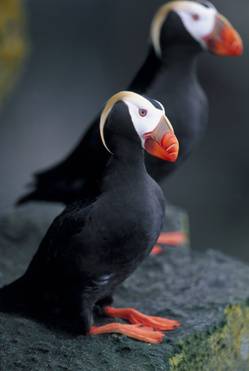NEW YORK (February 12, 2013) – The Natural Resources Defense Council (NRDC) today filed a petition with the U.S. Fish and Wildlife Service (USFWS) seeking Endangered Species Act listing for the California, Oregon, and Washington population of the tufted puffin, a small penguin-like seabird well-known for its distinctive facial coloring and plumage during the breeding season.
“If you can’t find food to eat, your days are numbered, and that is where the tufted puffin in these states finds itself,” said Brad Sewell, senior attorney at the Natural Resources Defense Council. “Climate change is doing a number on the iconic seabird’s populations by making fish scarce. This is on top of other harms from humans, like fishing and habitat destruction. We need to protect them before it’s too late.”
The charismatic seabird is found in the open waters, islands, and coastal cliffs of the North Pacific Ocean. Its habitat range within North America extends from northern California to Alaska. It is also found in Russia and a tiny remnant population inhabits two northern Japanese islands.
As a result of human activity, the tufted puffin population in the lower forty-eight states has plummeted in recent decades. In California, Oregon, and Washington, the breeding population has dropped by 85 to 90 percent in just three decades, from more than 30,000 birds to no more than 4000 today. Most of these remaining puffins are in Washington. Oregon and California each have breeding populations of less than 300 individuals.
The tufted puffin population is at risk in part because climate change is changing the temperature and circulation patterns of the Pacific Ocean, disrupting the food web and making it harder for puffins to forage. Puffins must increasingly compete with fishing fleets for available fish; the seabirds are also caught and drowned in fishing nets. Other threats to tufted puffins include oil pollution and harm or loss of habitat. The petition seeks ultimately to protect these populations and their habitat against such harms, for example by limiting fishing of certain fish populations that are critical to the tufted puffin’s diet.
Standing 15 inches tall, the tufted puffin is the largest of the three puffin species. It is named for the tufts of golden feathers that fan back behind its eyes during breeding season, accompanied by a bold white “face-mask” and bright reddish-orange beak and feet. Tufted puffins feed primarily on a variety of small fish, like sardines, anchovies, and herring, as well as some invertebrates, such as squid, octopus, and crab. They are expert swimmers, able to dive up to 60 meters to catch prey. When foraging to feed their chicks, tufted puffins can make as many as 350 dives per day. They can live for more than 20 years and usually mate for life.
The USFWS now has 90 days to provide a preliminary response to the petition. If the USFWS finds that the petition warrants additional review, the agency then has 12 months to make a final listing determination.
The Natural Resources Defense Council (NRDC) is an international nonprofit environmental organization with more than 1.4 million members and online activists. Since 1970, our lawyers, scientists, and other environmental specialists have worked to protect the world’s natural resources, public health, and the environment. NRDC has offices in New York City, Washington, D.C., Los Angeles, San Francisco, Chicago, Bozeman, MT, and Beijing. Visit us at www.nrdc.org and follow us on Twitter @NRDC.





